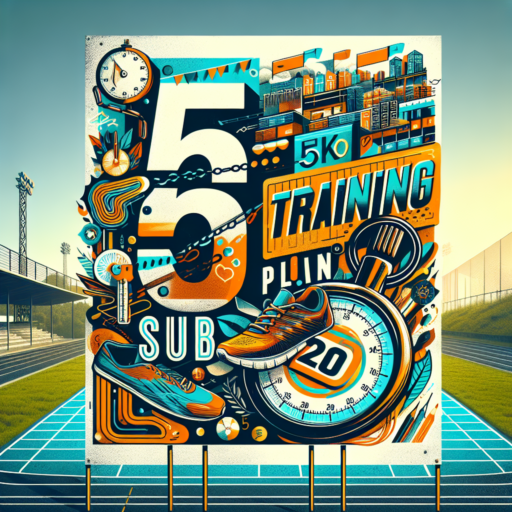Introduction to the 5km Training Plan for Sub 20 Minutes
Achieving a sub 20-minute 5km is a coveted milestone for many runners, marking a transition from average to competitive running. Whether you’re an experienced runner aiming to smash your personal best or a newcomer with a strong fitness base looking to set an ambitious goal, a carefully structured 5km training plan is essential. This guide introduces the key components and philosophy behind a training plan designed to break the sub 20-minute barrier, emphasizing tailored workouts, recovery, and incremental progress.
Understanding the Basics: The journey to a sub 20-minute 5km begins with a solid understanding of running fundamentals. This plan incorporates a mix of speed work, long runs, and interval training, all critical for improving your running economy and aerobic capacity. The balance of intensity and recovery is crucial, as it allows your body to adapt without the risk of injury. Through structured training, runners can gradually increase their speed and stamina, setting the stage for a successful 5km time trial.
Adherence to a holistic approach is also vital for success. Alongside the physical training, factors such as nutrition, sleep, and mental preparation play a significant role in achieving your sub 20-minute goal. Tailoring your diet to support recovery and energy levels, ensuring adequate rest, and fostering a positive mindset can significantly impact your training outcomes. Remember, the path to breaking the sub 20-minute mark is as much about optimizing your lifestyle as it is about the miles you clock.
Essential Preparations Before Starting Your 5km Training
Before embarking on your 5km training journey, it’s imperative to undertake a few essential preparations to ensure your body is ready and you can achieve your goals safely and effectively. These preparatory steps are not just critical for enhancing your performance but are also pivotal in preventing injuries.
Evaluating Your Physical Health
One of the first steps to consider before starting your 5km training is to evaluate your current physical health. It’s advisable to consult with a healthcare professional or a certified fitness expert to assess your fitness level. They can provide valuable insights into your cardiovascular health, flexibility, and muscle strength. This assessment can help tailor a training program that aligns with your physical capabilities and goals, significantly reducing the risk of injuries and health issues during your training regimen.
Choosing the Right Gear
Equipping yourself with the appropriate gear is another crucial preparation for your 5km training. The significance of selecting the right pair of running shoes cannot be overstated; these should offer the optimal balance of support, cushioning, and fit to suit your running style and the terrain you’ll be training on. Additionally, opt for comfortable, breathable clothing designed for running, which can help manage sweat and prevent chafing. Paying attention to your gear can immensely enhance your training experience and performance.
Developing a Nutritional Plan
A balanced dietary plan plays an indispensable role in your 5km training preparation. Nutrition fuels your body for training sessions and aids in recovery, making it essential to incorporate a variety of nutrients in your diet. Seek advice from a nutritionist to design a dietary plan that complements your training schedule and energy requirements. Emphasizing hydration, protein intake for muscle repair, and carbohydrates for energy will help maintain your stamina and overall health throughout your training period.
Week-by-Week Breakdown of the Sub 20 Minute 5km Training Plan
Reaching a sub 20 minute time in a 5km run is a coveted milestone for many runners. Achieving this goal requires a structured and disciplined approach to training. The week-by-week breakdown of the Sub 20 Minute 5km Training Plan is meticulously designed to incrementally build your speed, endurance, and running efficiency. The key is progressing through varied workouts that challenge your body in different ways, optimizing your ability to run faster over the distance.
At the outset, Week 1 focuses on establishing a solid aerobic base, incorporating short, moderate-paced runs with a mix of speed drills to gently introduce your body to the faster paces required. As you move into Week 2 and Week 3, the training intensifies with longer distance runs and hill workouts. These weeks are crucial for building muscle strength and improving your VO2 max, setting a strong foundation for the more demanding sessions ahead.
The real challenge begins from Week 4 onwards, where interval training becomes a staple. These sessions are designed to push your speed boundaries and improve your lactate threshold. It’s during this phase that you’ll also include tempo runs—these are crucial for teaching your body to sustain faster paces over longer distances. The successive weeks build on this structure, gradually increasing the intensity and length of each key workout to ensure continuous improvement.
Key Workouts to Improve Your 5km Time
Improving your 5km time comes down to incorporating a variety of workouts into your training regimen. These workouts target different aspects of your running, such as speed, endurance, and economy, to shave off precious seconds or even minutes from your personal best. Here, we delve into some key training exercises that are proven to boost your performance.
Interval Training
Interval training is paramount for boosting your speed and endurance. This workout involves running short distances at a high intensity followed by a period of low intensity or rest. For instance, sprinting for 1 minute followed by 2 minutes of jogging or walking. Repeating this cycle 5-10 times not only improves aerobic capacity but also teaches your body to recover more efficiently. It’s recommended to incorporate interval training into your schedule 1-2 times per week to see significant improvements.
Tempo Runs
Tempo runs, or threshold runs, are designed to increase your running economy and delay muscle fatigue. This workout involves running at a challenging but sustainable pace for a prolonged period, typically 20-30 minutes, without slowing down. The goal is to run at the fastest pace you can sustain for the entire duration, which trains your body to run more efficiently at a faster pace. Mixing tempo runs into your weekly training can help elevate your lactate threshold and improve your endurance.
Hill Repeats
Hill repeats are another game-changer for 5km runners looking to enhance their strength and speed. This workout focuses on running up a hill at a hard effort, then jogging or walking back down for recovery. Performing 6-10 repeats depending on the hill’s length and incline not only develops power in your leg muscles but also boosts your cardiovascular strength. Additionally, hill repeats improve your running form and economy, making every step on flat ground feel easier and more efficient.
Incorporating Speed Work into Your Training Plan
Integrating speed work into your regular training regimen is an unparalleled strategy for improving your running efficiency and trimming down your PRs (Personal Records). Not only does it bolster your aerobic capacity, but it also enhances your running economy and fortitude. This segment of your training is centered on brief bursts of high-intensity runs followed by recovery periods, allowing your body to adapt to faster paces gradually.
Understanding the Basics of Speed Work
At its core, speed work involves a series of controlled, high-effort activities designed to increase your running speed. Common forms of speed training include intervals, tempo runs, and fartleks, each serving a distinct purpose in your training arsenal. Intervals consist of short, intense efforts followed by equal or slightly longer recovery periods. Tempo runs, often referred to as the «comfortably hard» pace, aim to elevate your lactate threshold, while fartleks, a more flexible training approach, blend periods of fast running into your regular long runs.
Effectively Integrating Speed Work into Your Routine
For beginners, the key to successfully incorporating speed work lies in moderation and gradual progression. Starting with one speed session per week is advisable, gradually increasing the intensity and volume as your body adaptes. It’s crucial to prioritize rest and recovery, allowing your muscles to repair and grow stronger. Remember, speed work should complement your training, not compromise it. Balancing high-intensity workouts with easier, recovery-focused runs is essential for preventing overtraining and injuries.
Timing is everything when it comes to speed work. Ideally, these sessions should be placed on days following rest days or easy run days, ensuring your body is well-rested and primed for the demands of high-intensity effort. Additionally, incorporating strength training exercises specific to runners can further enhance the benefits of your speed work, providing the muscular endurance necessary to maintain higher speeds over longer distances.
Strength Training and Conditioning for 5km Runners
While many 5km runners focus primarily on clocking ample mileage to improve their running prowess, incorporating strength training and conditioning into your regimen can significantly enhance your performance, speed, and resilience. This regiment is not about bulking up but about fortifying your body to become a more efficient runner. The advantages of integrating strength training include improved endurance, increased power, and a reduced risk of injury.
Strength training particularly aids in stabilizing the muscles used during running, thereby improving your running mechanics and efficiency. For 5km runners, this means focusing on exercises that strengthen the core, legs, and glutes—muscles that are pivotal for propulsion, balance, and sustaining pace. Conditioning exercises, on the other hand, enhance cardiovascular health, enabling runners to maintain a robust pace without quick fatigue.
Effective conditioning routines might involve interval training which cycles through periods of high-intensity effort followed by recovery. This type of training mimics the variations in pace a runner experiences during a 5km race, preparing their body to handle changes in speed and intensity. Combining strength and conditioning efforts ultimately leads to a more competitive and resilient runner, capable of achieving personal bests and withstanding the rigors of the race with fewer injuries.
No se han encontrado productos.
Recovery Strategies to Enhance Your 5km Training
When embarking on a rigorous 5km training regimen, implementing effective recovery strategies is as crucial as the training itself. Recovery is the hidden ingredient that allows for continuous improvement, helping to reduce injury risk and ensure that each training session can be tackled with vigor. Here, we delve into recovery tactics that can significantly enhance your 5km training efforts.
Optimize Your Post-Run Nutrition
Proper nutrition plays a pivotal role in recovery. After a grueling training session, your body craves nutrients to repair muscle tissues and replenish energy stores. Consuming a balanced mix of proteins and carbohydrates within 45 minutes after your run can expedite the recovery process. Foods rich in antioxidants and omega-3 fatty acids, like salmon and berries, can also help reduce inflammation, thus shortening recovery time.
Incorporate Active Recovery
While it might seem counterintuitive, engaging in low-intensity activities on your rest days can facilitate muscle recovery and enhance blood circulation. Activities such as yoga, swimming, or a gentle bike ride can help flush out lactic acid buildup, reducing muscle soreness and stiffness. These activities also provide an excellent opportunity to enhance your training without overexerting the muscles used during your 5km runs.
Remember, recovery should not be an afterthought in your 5km training plan. By incorporating these strategies, you can ensure that your body is adequately prepared to handle the demands of training, ultimately leading to improved performance and a reduced risk of injury. Listen to your body, and don’t hesitate to adjust your recovery practices as you progress in your training journey.
Nutrition Tips for Optimal Performance in 5km Races
Preparing for a 5km race goes beyond regular training sessions and stretching routines; your nutrition plays a pivotal role in achieving optimal performance. What you consume before, during, and after the race can significantly impact your energy levels, recovery time, and overall experience. Here are focused nutrition strategies designed specifically for 5km racers.
Before the Race: Carb-Loading and Hydration
Carbohydrates are your main energy source during a 5km race. Loading up on carbs a few days prior to the race can enhance your energy reserves. Opt for complex carbohydrates such as whole grains, oatmeal, and sweet potatoes for sustained energy release. Equally important is staying hydrated. Begin hydrating several days before the race, aiming for at least 8 glasses of water per day, and consider drinking a sports drink the day before to top off your electrolyte levels.
During the Race: Energy Boosts
While a 5km race might not require the same fueling as a marathon, a quick energy boost can be beneficial, especially for improving your race time. Energy gels or chews can be an efficient source of rapid glucose. However, it’s crucial to test these products during your training runs to ensure they sit well with your stomach. Additionally, sip on water or an electrolyte drink to maintain hydration without overdrinking.
After the Race: Recovery Nutrition
Post-race nutrition focuses on recovery. Consume a meal rich in proteins and carbohydrates within two hours of completing the race to aid muscle repair and replenish glycogen stores. Foods such as Greek yogurt, fruit, or a smoothie can be ideal choices. Continuing to hydrate is also vital, as rehydration assists in the recovery process and prepares your body for the next challenge.
Common Mistakes to Avoid in Your Sub 20 Minute 5km Training
When striving for a sub 20 minute 5km run, dedicating focus and consistency towards your training is crucial. However, even the most committed athletes can fall victim to common mistakes that can hinder their progress or even result in injury. Recognizing and avoiding these errors early on is key to enhancing your performance and achieving your goals.
Ignoring Recovery Days
One significant mistake runners make is underestimating the importance of recovery days. It’s a common misconception that more runs equal better results, but without allowing your body to recover, you’re risking overtraining and injuries. Integration of rest days in your schedule promotes muscle healing, prevents fatigue, and actually strengthens your running capabilities in the long run.
Overlooking Proper Nutrition
Another area often overlooked is proper nutrition. Fueling your body with the right balance of carbohydrates, proteins, and fats is essential for optimal performance and recovery. Neglecting nutrition can lead to a lack of energy during training sessions, slower recovery times, and an overall decrease in performance. Additionally, staying hydrated is critical, especially during intense or long training sessions.
In conclusion, aiming for a sub 20 minute 5km requires not only rigorous training but also a mindful approach to rest and nutrition. Identifying and modifying these common mistakes can significantly improve your running efficiency and help you achieve your goal more effectively.
Measuring Progress and Adjusting Your Training Plan
Keeping track of your progress and making necessary adjustments to your training plan is crucial for achieving your fitness goals. Whether you’re training for a marathon, looking to lose weight, or simply working towards a healthier lifestyle, understanding how to effectively measure your progress can be the difference between success and stagnation.
One key aspect of measuring progress involves setting clear, objective benchmarks or goals at the outset. These can range from quantitative targets, like a specific weight, to qualitative objectives, such as improving endurance. Regularly tracking your performance against these benchmarks allows for a factual basis to evaluate your progress.
Adjusting Your Training Plan Based on Feedback
Adjustment is an essential part of any training plan. As you measure your progress, you’ll discover areas that may require more focus or a different approach. This could mean increasing the intensity of your workouts, altering your diet, or even allowing more time for rest and recovery. Listening to your body and being flexible in your plan ensures continual improvement and helps avoid plateaus or overtraining.




